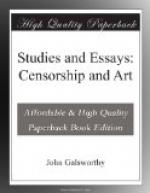So, how thin often is the hedge! And how poor a business the partisan abuse of either kind of art in a world where each sort of mind has full right to its own due expression, and grumbling lawful only when due expression is not attained. One may not care for a Rembrandt portrait of a plain old woman; a graceful Watteau decoration may leave another cold but foolish will he be who denies that both are faithful to their conceiving moods, and so proportioned part to part, and part to whole, as to have, each in its own way, that inherent rhythm or vitality which is the hall-mark of Art. He is but a poor philosopher who holds a view so narrow as to exclude forms not to his personal taste. No realist can love romantic Art so much as he loves his own, but when that Art fulfils the laws of its peculiar being, if he would be no blind partisan, he must admit it. The romanticist will never be amused by realism, but let him not for that reason be so parochial as to think that realism, when it achieves vitality, is not Art. For what is Art but the perfected expression of self in contact with the world; and whether that self be of enlightening, or of fairy-telling temperament, is of no moment whatsoever. The tossing of abuse from realist to romanticist and back is but the sword-play of two one-eyed men with their blind side turned toward each other. Shall not each attempt be judged on its own merits? If found not shoddy, faked, or forced, but true to itself, true to its conceiving mood, and fair-proportioned part to whole; so that it lives—then, realistic or romantic, in the name of Fairness let it pass! Of all kinds of human energy, Art is surely the most free, the least parochial; and demands of us an essential tolerance of all its forms. Shall we waste breath and ink in condemnation of artists, because their temperaments are not our own?
But the shapes and colours of the day were now all blurred; every tree and stone entangled in the dusk. How different the world seemed from that in which I had first sat down, with the swallows flirting past. And my mood was different; for each of those worlds had brought to my heart its proper feeling—painted on my eyes the just picture. And Night, that was coming, would bring me yet another mood that would frame itself with consciousness at its own fair moment, and hang before me. A quiet owl stole by in the geld below, and vanished into the heart of a tree. And suddenly above the moor-line I saw the large moon rising. Cinnamon-coloured, it made all things swim, made me uncertain of my thoughts, vague with mazy feeling. Shapes seemed but drifts of moon-dust, and true reality nothing save a sort of still listening to the wind. And for long I sat, just watching the moon creep up, and hearing the thin, dry rustle of the leaves along the holly hedge. And there came to me this thought: What is this Universe—that never had beginning and will never have an end—but a myriad striving to perfect pictures never the same, so blending and fading one into another, that all form one great perfected picture? And what are we—ripples on the tides of a birthless, deathless, equipoised Creative-Purpose—but little works of Art?




